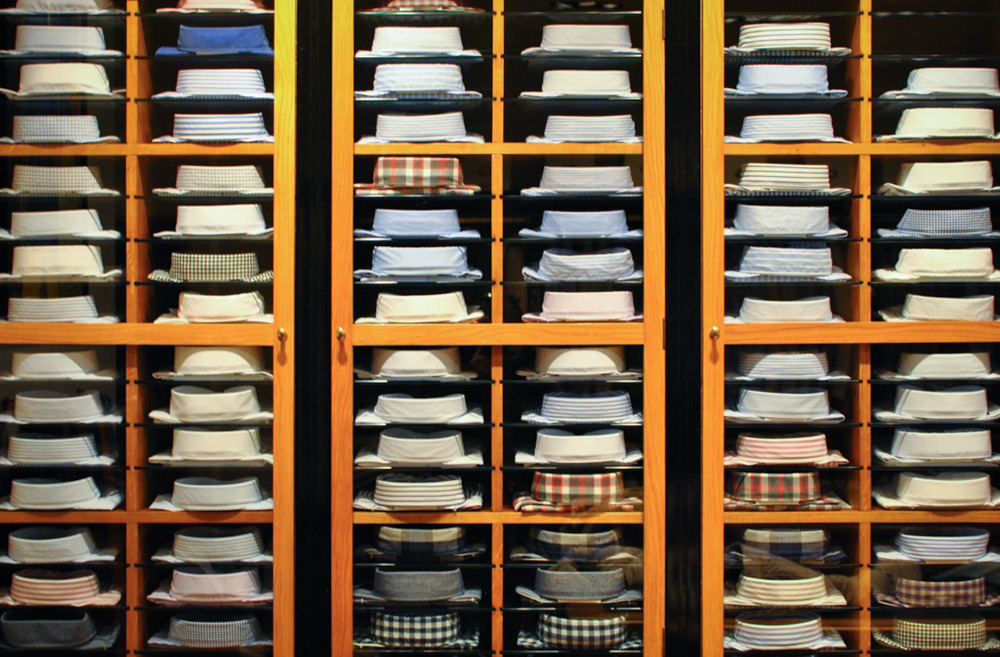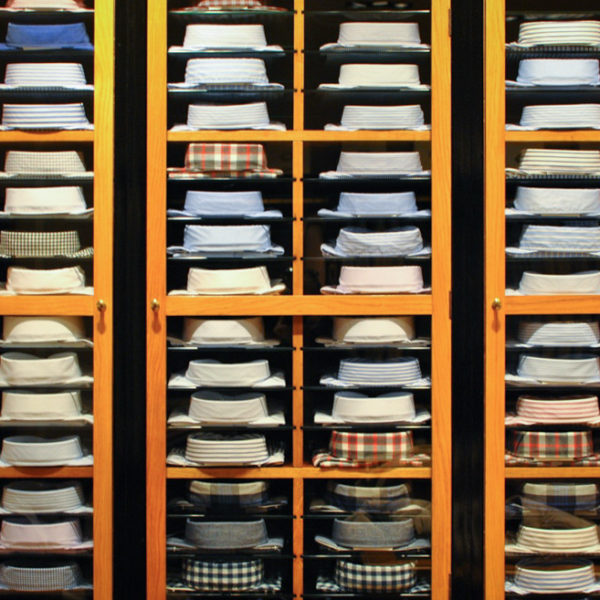
Although certain shirting fabrics and tweeds get a lot of attention, we often focus on the way a shirt or suit is made and styled vs what it’s made of. It’s an understandable choice: it’s easier to distinguish (especially in photos) between two shirts with different collar styles than similarly made shirts made of two different grades of blue oxford fabric. Likewise, “objective” measures of fabric quality and fabric origin rarely tell the whole story. People throw around “80s two ply” or “super 120s” like they’re the “dual overhead camshaft” of suit fabrics, and in a way that’s true, because i have no idea what a dual overhead camshaft is.
But whether patterned or plain, fabric is often the most distinctive component of your shirt or suit (I’m mostly talking about wovens here, knits are a slightly different beast). How the fabric comes to be a part of your garment depends a lot on where you’re buying your clothes. Essentially, no matter the brand or maker, your fabric has to be designed, then made, then cut and sewn into clothing.
Major Brands
Fashion giants make enough clothes that they can specify every aspect of the fabric they use from the mills they buy from, primarily in China. Ralph Lauren, for example, doesn’t own factories or make its manufacturing relationships public, but in 2008 it was estimated that 98 percent of the dollar value of Ralph Lauren clothing was made in China.
That doesn’t mean the fabric is low quality. Brands at that level employ fabric designers, and can order massive quantities exclusive to their brands or stores, and can specify fabric content, appearance, shrinkage, etc. down to the dye of a single yarn fragment. Although the work is outsourced, brands that produce the volume of clothing that the RLs of the world do control the process from fabric design to production to cut and sew. These brands will also often wash fabrics or constructed garments so they look their best on display in a store–how they fare once you get them home and wash them may be less of a concern.
Rare exceptions like Brunello Cucinelli are more vertically integrated–Cucinelli employs the designers, fabric mills, and manufacturers. The Cucinelli empire is reported to be a borderline ridiculous utopia.
Medium-sized Wholesale Brands
Name brands that offer tailoring (think Rag + Bone, Band of Outsiders type brands) don’t usually own the means of production either. They buy from makers like Southwick, or Samuelsohn, or Individualized Shirts (these makers, in turn, sometimes have their own lines… it can get confusing). These makers don’t produce their own fabric though–they source it from textile mills all over the world.
Much like retail buyers go to Pitti Uomo and other tradeshows, makers and designers go to textile tradeshows and visit mills where they’re presented with a menu of classic and newly designed fabrics. A maker selects fabrics and, in turn, might present a designer with samples of dozens of different fabrics, some varying a lot season to season, and some evergreens (like cotton oxford, or wool flannel) that wax and wane in popularity but are pretty much always available. In this way, a maker has a lot of say in what you’ll be wearing seasons in advance–they’re narrowing down the range of available fabrics. Who knows what horse blankets you’ve missed out on?
So, for example: a fabric designer working for a mill designs a plaid fabric, the mills markets it, a maker takes it back to the factory, and a designer selects the plaid. The selection goes back up the chain–assured of an order, the mill churns out the fabric, the maker buys it and sews the clothes, selling them to the designer, who sells to a retailer, who sells to you. These people all need to get paid, contributing to the retail cost to you.
This system is also one reason you’ll see the same fabric from several different lines–they may have their tailored clothes made in the same place, and all picked the same fabric. Depending on the mill, buying exclusive rights to a fabric could mean buying thousands of yards of fabric. Most “designers” do not design their own fabrics–it’s just not realistic. A notable exception is Stephan Schneider.
House Labels and Small Lines
In part because classic tailoring involves a relatively limited number of possibilities (jackets, shirts, pants), and design comes down to selecting details, sometimes the retail and design operations overlap. Stores like Winn Perry or Epaulet don’t have the economies of scale of mall brands, so they’re less likely to be able to specify far in advance exactly what they want their fabric to look like. Likewise, they don’t have the time or money to custom design fabrics. For some garments, these stores can go through the same basic process as the mid-tier brands, ordering from a menu at a maker’s factory. Makers and fabrics mills have minimum quantities they need to make in order to profit, so if a store can only afford to make a small run of garments, their options are somewhat limited.
On the flipside, these smaller labels have flexibility larger operations do not, and sometimes stumble on unusual, short-run fabrics that fit their needs perfectly. Many of these fabrics come from Japan, which exports a lot of fabric in this small-run arena, fabric then marketed by regional salesmen or jobbers in the US and elsewhere. They can then take this fabric to a manufacturer who does “CMT” (cut, make, and trim–you provide the fabric), and have the garment made. Sometimes this means you get access to a rad shirt in a fabric you’ll never see elsewhere. On the other hand, that exclusive limited edition shirt you’re coveting might only be limited because it’s made from a roll of fabric that didn’t sell, and so was never made in quantity.
Quality
What does this all mean for fabric quality? Not much, to be honest. For us consumers, quality is often the extent to which a fabric meets our needs and wants. Are you looking for lightweight or heavy fabric? Does the fabric wrinkle easily? (Is it intended to do so, or is it just not behaving?) Does it have a dry hand, or is it silky? (“Hand” is to fabric description what “mouthfeel” is to food writing.) Sometimes you want a very refined fabric, and sometimes you want a reassuringly scratchy tweed. Sometimes all that matters is that the gingham is the perfect scale.
I’ll have another post up soon discussing some of the technical language used to market fabric (super 120s included).
–Pete
